CONSTELLATION GUIDE
Last updated: 25 June 2001
CONSTELLATION GUIDE |
"GO TO"....PEGASUS
An Upside Down Mighty Winged Steed Born from the Blood of a Bad Hair Day
From: sherrodc@ipa.net (Clay Sherrod)
In this nineteenth Constellation Guide, "GO TO PEGASUS" of the series "GO TO GUIDES for the ETX and LX 90 Telescope Users" we begin to get a taste of impending fall....a season that brings with it not only very clearly defined and wonder-filled bright starry constellations, but also the precursor of those crisp and deep clear nights of September and October in the Northern Hemisphere.
Although containing only ONE deep sky object - Messier 15 - Pegasus is a wonderful constellation for close study,with many faint galaxies, scores of wonderful double and multiple stars and some fascinating early lore and history associated with the constellation itself as well as many of the stars within it.
Pegasus is located high north of the Celestial Equator (the "0" demarcation line in declination) and hence all objects for our "GO TO" TOUR will have positive ("+") declinations. The most identifiable "sky mark" of this very large constellation is the famous "Great Square," its namesake derived from the nearly perfectly square asterism (pattern) formed by the bright stars Alpheratz (actually in Andromeda to its east), Algenib, Scheat and Markab, a large quadrilateral that forms a square almost 12 degrees wide in declination and stretches some 15 degrees (almost a perfect "hour" in Right Ascension) across the sky.
At dark on August 15 each year, from about 35 degrees north latitude, the square of Pegasus will be seen rising in the ENE sky about 9 p.m. The star Enif, far to the square's west will rise significantly earlier - about 6 p.m.....that will give you some idea of the great expanse of this constellation! Enif passes (culminates) nearly overhead from that latitude on Midnight of August, while the Great Square sees midnight culmination nearly ONE MONTH LATER! The constellation is very favorably placed for all-night viewing during August and September each year.
-------------------------------
One Horse....two wings.....many tales -
There perhaps is no other mythological fable that has invoked so many variations of a theme throughout the early Arabic and Grecian golden period of gods, heroes and tall tales that Pegasus....the beloved horse (although it came to be through evil means) has been the central figure in a wide variety of exploits and fireside stories of old.
There has never been much dissention in that this constellation represents the fabled "Winged Horse" or "Flying Horse". In fact, so important is the Greek legend of this flighty animal that it was immortalized in one of the most symbolic of all American institutions: the oil industry. We all have seen the muscular and mighty flying steed which graces the red, white and blue emblazoned signs of the Mobile Oil Company.
A fitting tribute that could hardly be rivaled by any other association.
In Greek mythology, and reinforced by the Arabian namers-of-the-stars through the beautiful star names given to the brighter members of this constellation, the large star pattern represents a beautiful, peaceful and dedicated (yet most unusual) airborne horse that sprang from the spilled blood of the horrid snake-headed troll of a woman, MEDUSSA after she was slain by the Greek hero Perseus (who, by the way, follows the horse quite closely to the East in the skies). But the flying horse concept is only one of many variations and evolutions of the original association of the constellation:
1) Association with fresh spring waters - the earliest Greek derivative of the name "Pegasus" comes from the translated words for "Ocean Springs"; later versions tweaked the words slightly to denote "the strong one," for his ability to buck so forcefully on the mountains of Cornith that his hooves cracked open the Earth and released the pure spring waters of Peirene, still flowing freely today thanks to the mighty bucking bronco. In addition, Pegasus appears to have mythologically tapped (hoofed?) the spring waters of Mount Helicon nearby. Although obviously important to the writers of the legends, the particular significance of a horse providing spring water to a land not particularly drought-stricken is puzzling.
2) Heroic feats - As if springing from the bloods of snake-headed Medusa was not enough, Pegasus was well know for some very superhuman (oh...."superhorse") deeds. First, and most obvious, was the fact that he could fly. Several Greek interpretations of the origin of the Pegasus name suggest that it signifies NOT an association with the ability to crack open the earth and provide springwater, but that of STRENGTH instead. Pegasus, although tamed into submission by Athena, was still will and heart and brave by ancestry. It was this horse that carried all the lightening and thunder bolts that were so skillfully tossed around by the great Greek god Zeus. It was Pegasus who carried the hero Bellerophon en route to slay the horrible Chimaera (an odd creature with the heads of a lion, a snake and a goat). As legend has it,however, the winged horse and Bellerophon had a "falling out..." Literally. Bellerophon decided that, because of his great deeds and heroics, he was "godlike" and could ascend via the winged horse up to the house of the gods at Olympus, much to the ire of Zeus. The horse grew weary of all the heroic escapades - and assisted by the sting on the rump by a mighty insect sent by Zeus - Pegaus simply bucked him and threw him to earth, blinding and crippling him forever. As a just reward to the steed, Zeus allowed the horse to ascend to Olympus in the sky forever sparkling in the constellation that we see today, to never carry a rider again.
3) Biblical and religious associations - Pegasus has also been linked as the horse which carried Nimrod in the earliest Jewish legends as well as the actual image of GABRIELE the archangel.
Perhaps one of the most curious aspects of just how we have assigned a horse - much less a "winged horse" - to this star pattern is the fact that, in order to make the stars "work" even close to resembling a winged horse, you must look at the pattern upside down...this is similar to the curious situation of Hercules, another Greek hero (http://www.weasner.com/etx/ref_guides/hercules.html ), who also is denoted upside down....something very unbecoming of such significantly-respected heroes of old!
Regarding the interesting objects in the huge constellation of Pegasus, refer both to the detailed "GO TO" TOUR map shown below; click on this map to open, save it to a file on your computer and open it to re-size to fit your printable desktop paper. Print out and use as your TOUR guide for Pegasus.
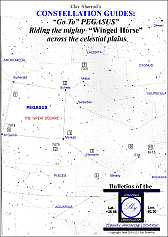
Note from the sky chart included here that the CELESTIAL EQUATOR passes directly south of Pegasus. This is the reading "0" degrees on your properly adjusted declination setting circle. All angles NORTH of this equatorial line are positive ("+") and all angular measures (declinations) south of the celestial equator are negative ("-"); hence you will see references in this "GO TO" GUIDE to only "+" declinations when referring to Pegasus objects since all are NORTH the "0" declination equator.
In addition to all the GO TO objects for your Pegasus Tour, you will note an abbreviated listing of many "ngc galaxies" that are good, albeit difficult, objects for the ETX 125 and LX 90 at the end of the Concise Listing which follows.
----------------------------------
Each GO TO object in Pegasus is discussed for your telescope regarding the type of conditions necessary for you to view it optimally for discern the very faintest details.........magnifications and aperture necessary for most objects, and much, much more. This is YOUR complete GUIDE to get you on your way to exploring the best objects in Pegasus with your computerized telescope and its GO TO function. The following listing of "BEST" objects contains the finest or most interesting....as with our "GO TO" TOUR of Coma Berenices (http://www.weasner.com/etx/ref_guides/coma-berenices.html ) and Virgo (http://www.weasner.com/etx/ref_guides/virgo.html ) there is ALSO a bonus comprehensive listing of ALL NGC GALAXIES (they are on your AutoStar) that can be seen in at least one or more of our telescope size ranges *(faint ngc objects that are NOT visible in at least the LX 90 are NOT included in these "GO TO" TOURS)*.
Use this attached star chart and the following Guide as an excellent reference for your next star party itinerary, or a beginning for further study into the thousands of objects visible in this part of the sky. Truly these extensive Constellation Study Guides will most definitely put your AutoStar to work for you in the most efficient and enjoyable way possible! As a matter of fact, MANY AutoStar users are now programming their own "Tours" based on these guides, using each constellation as a separate GO TO Tour for the AutoStar library that can be added in or deleted through the main edit screen on your PC or MAC computer.
We hope you enjoy these comprehensive GUIDES to touring the constellations via your AutoStar and its computer-driven telescope. Each new installment is complete with diagrams, charts and illustrations that you will find nowhere else. Please let us hear YOUR feedback and your observations of each and every constellation after YOU have toured its vast reaches of our skies!
-----------------------------------
YOUR PEGASUS CONCISE DIRECTORY OF INTERESTING OBJECTS -
While there are literally thousands of faint galaxies within the borders of Pegasus, only a handful are visible to the ETX and LX scopes and even those are beyond reach of all but the ETX 125 and LX 8" and above. Thus, only the brightest (and THEY are still quite faint!) and in some cases, most challenging, objects are chosen for this brief tour. Two of those galaxies listed CAN be glimpsed adequately in the ETX 90.
I have chosen the finest (or most interesting) 17 objects in this PEGASUS "GO TO" TOUR; as with all GUIDES, all objects listed below will be visible in all telescopes (some naked eye) from the ETX 60 through the LX 90; of course larger apertures may "show" an object a bit closer and "better," but frequently a wide field and low power view is more desirable than aperture for FINDING THESE objects! Indeed, I strongly encourage you first locate the object, or its approximate location through your GO TO function with your lowest power and then - once IDENTIFIED positively - move up slowly in steps with magnification.
You will find that there is an "optimum magnification" with which to observe each and every object, from the brightest to the dimmest. Too much "power" and you will darken the object as well as the field of view; not enough "power" and there might not be enough contrast between the dark background sky and the faint image of the "faint fuzzy" deep sky object! Once your eyes are fully dark adapted, you will even be able to see fainter stars and more deep sky object detail that at first might not even be glimpsed! I have found through practice that about 15x per inch aperture is PERFECT for good direct deep sky viewing once found (36x for the ETX 60/70; 55x for the ETX 90; 75x for the ETX 125; and, 125x for the LX 90).
With all deep sky objects, and particularly small and faint galaxies, avoid attempting to observe when the moon is in the sky, even a very thin crescent, as its brightness in the sky will overshadow the very dim contrast afforded by even the brightest deep sky object; if you see the object at all against moonlight, you will NOT see the subtle outlying areas or the full detail of what is presented.
The wonderful sky placement of Virgo lends itself well to very good and long-period observing for ETX and LX 90 users, particularly those in the northern hemisphere. When rising about dark in the east in mid-August, it will remain in the sky throughout the night, transiting the meridian at about midnight during late summer. All deep sky objects and difficult double stars are ALWAYS best observed when they are located nearly overhead (or as high in the sky as possible), thus requiring the observer to look through the thinnest portion of the Earth's "lens" of atmosphere and haze. Hence, northern hemisphere observers will want to wait until the constellation transits the meridian to provide as high a view as possible.
As with all of the "GO TO" TOUR constellation lists, I recommend a good star atlas and/or chart which will list all the finest objects, constellation-by-constellation. One very handy reference guide is the PETERSON FIELD GUIDE TO THE STARS AND PLANETS, which features complete lists with declinations, right ascensions, magnitudes, and all pertinent information for you to expand your observing horizons beyond this brief GUIDE.
Note that your AutoStar will NOT have every object listed on every constellation GO TO tour....this is intentional. You can access some of the most interesting objects of the sky directly from their coordinates. It is quite simple as you merely enter these coordinates as follows in the 10-step process:
1) Press the "MODE" key and hold down for 3 seconds and release;
2) Displayed will be the current Right Ascension and Declination of the center of field of view of where your telescope is presently pointed (assuming that you have properly aligned from "home position");
3) [NOTE: if you have the Meade electric focuser attached to any of the ETX or LX telescopes, holding down the "MODE" key will bring up the "Focus" command first....merely scroll (lower right scroll key) down one step to access the RA and DEC to enter your desired coordinates]
4) Press the "GO TO" button on AutoStar;
5) This will change the display and you will note the cursor blinking over the first digit of RIGHT ASCENSION (R.A.); merely use the number keys and dial in the R.A. of the object you are searching for;
6) When done, press "Enter;"
7) This moves the blinking cursor over the "DEC" coordinates;
8) [NOTE: the declination, unlike R.A., can be either positive or negative and you will see the "+" or "-" sign displayed depending on where your telescope is aimed at that time; if it is NOT the desired setting (plus or minus), merely use your arrow key to move the blinking cursor OVER the "+" or "-" sign and change by using either of your lower corner SCROLL KEYS;
9) Proceed to enter the DEC using number keys;
10) Press either "Enter" or "Go To" when finished and the telescope begins slewing to your desired object!!
The constellation tour Star Chart above (click on and save to a file on your PC; then open it and re-size to fit the page and print for a very handy at-the-scope star chart) will get you started on your journey for this constellation.
Following is the concise object list for your "GO TO" TOUR of PEGASUS; you may wish to find the majority of the objects from the AutoStar Library (for example, you can easily go to "MESSIER 15" if you pull up "Object/Deep Sky/Messier Object/..type in '15'...." and then press "Enter", followed by "GO TO" to access this very nice and bright globular cluster. On the other hand, if you want to experiment and become a "better AutoStar user" try entering the exact R.A. and DEC coordinates of that object as described above after holding down the MODE key. You will find the accuracy of entered GO TO's to be somewhat less than those stored in AutoStar, but the capability of acquiring unlisted objects is fantastic!
Of course, for named objects such as the starter star "Markab" (alpha Pegasi), you might choose to merely key in SELECT / OBJECT / STAR / NAMED....and scroll to Markab. Enter and then press " GO TO" and you are off to your first object!
OBJECT 1:
bright star - MARKAB (alpha Pegasi) - R.A. 23h 02' / DEC + 14 56 - Magnitude: 2.5 / NW "corner"
OBJECT 2:
bright red star - SCHEAT (beta Pegasi) - R.A. 23h 01' / DEC + 27 49 - Mag: 2.5 to 3.1, variable reddish!
OBJECT 3:
test star - HOMAN (zeta Pegasi) - R.A. 22h 39' / DEC + 10 34 - See if you can find the 11th mag. star!
OBJECT 4:
tough double - 37 Pegasi - R.A. 22h 27' / DEC + 04 11 - Mags: 5.8 & 7.0, really tough for ETX 125+
OBJECT 5:
good one for LX 90 - 85 Pegasi - R.A. 24h 00' / DEC + 26 49 - Mags: 5.8 & 8.5 - very close, 0.8"
OBJECT 6:
nice variable - AG Pegasi - R.A. 21h 49' / DEC + 12 23 - Mag: 9 to 6; a permanent nova? 6th mag. now!
OBJECT 7:
spiral galaxy - ngc7331 - R.A. 22h 35' / DEC + 34 10 - Magnitude: 9.7, very good object for ETX 90 +
OBJECT 8:
spiral galaxy - ngc7814 - R.A. 00h 01' / DEC + 15 51 - Magnitude: 12.4, very difficult but distinct!
OBJECT 9:
spiral galaxy - ngc7479 - R.A. 23h 02' / DEC + 12 03 - Magnitude: 11.6, interesting shape, very long!
OBJECT 10:
globular cluster - Messier 15 (ngc7078) - R.A. 21h 28' / DEC + 11 57 - Magnitude: 6.7, very dense, rich
OBJECTS 11 THROUGH 19 - NGC GALAXIES PEGASUS (other than those listed above)
listing of "ngc" galaxies in Pegasus in order of RIGHT ASCENSION (and NGC # order)
NOTE: These NGC galaxies may NOT be detailed in the following "Visual Guide"
as are those Objects 1-10 listed above...use the abbreviated descriptions as they follow the order:
NGC# / R.A. / DEC / MAGNITUDE / SIZE (in minutes arc -'-) / GALAXY TYPE , description
ngc7814 / 00 01 / +15 51 / 12.4 / 3.0 X 0.8 - spiral, very edge-on and large...but dim, LX 90 only
ngc7177 / 21 58 / +17 29 / 11.9 / 2.1 X 1.1 - spiral, oval tilted, fairly small and should be seen in ETX 125
ngc7217 / 22 06 / +31 07 / 11.0 / 2.6 X 2.3 - nice large & fairly bright spiral, ETX 125 and LX 90 easy object
ngc7332 / 22 35 / +23 32 / 11.8 / 2.3 X 0.6 - very "squashed" elliptical, starlike and faint - ETX 125 & LX 90
ngc7448 / 22 58 / +15 43 / 11.2 / 2.0 X 1.0 - face-on spiral, fairly bright and possible in ETX 90
ngc7479 / 23 02 / +12 03 / 11.6 / 3.4 X 2.6 - very nice but faint barred spiral; use ETX 125 and LX 90 for this
ngc7741 / 23 41 / +25 48 / 11.6 / 3.0 X 2.0 - similar to above, at same magnitude and size (triplet with below)
ngc7742 / 23 42 / +10 29 / 11.9 / 0.9 X 0.9 - very tiny and faint elliptical; probably only in the LX 90; starlike
ngc7743 / 23 42 / +09 39 / 12.0 / 1.6 X 1.4 - # 3 of the above triplet, faint tiny spiral, possible in ETX 125
....SO LET'S GALLOP AWAY ON OUR CELESTIAL STEED!! (refer to the Pegasus Star Chart for all the objects described in detail on the "Guide")
---------------------------------
A VISUAL GUIDE TO OUR DEEP SKY OBJECTS IN PEGASUS -
Object 1 - Bright Star - "MARKAB" (alpha Pegasi)
Our starting point for every "GO TO" TOUR is always (or usually!) the brightest star of the constellation or region. At a distance of 110 light years and a magnitude of only 2.5, the Rosette stone of Pegasus is not much of a spectacular object. However, this is a really good time to discuss the rich history of star names - beautiful and enriching star names - that were placed upon so many of our brighter stars by the ancient Arabian skywatchers. The brighter stars of Pegasus were aptly named for the most part, perpetuating the lore of the winged horse and its importance in early civilized mythology. Let us examine some of the names of the special stars of Pegasus. Remember that the horse is UPSIDE DOWN in out skies....the four stars of the "Great Square (Markab, Scheat, Al Genib and Alpheratz (this one in Andromeda) comprise the horses' BODY; (see chart above; Pegasus' front legs are marked by the stars Matar and Sadalbari, and his head a great distance to the west, set by the AutoStar reference star "Enif." Let us look into some of the colorful horse-related star names for select Pegasus landmarks:
Alpha - "Markab" - this is most definitely a "horse named-star," except in some of the very earliest Arabic associations. Earliest designations associated this star with "Marchab," the ship on the water. The range of names that place this star as part of a horse's anatomy vary throughout Arabic times, including "Markab" (the horse's saddle), "Matn Alfaras" (the horse's shoulder), and finally "Yed Al Pheras", or the horses hoof.
Beta - "Scheat" - Do you remember another "Scheat" name associated with a star in Aquarius ( there is, and you can find it at http://www.weasner.com/etx/ref_guides/aquarius.html . The name is from the Arabic "Al sa'id" , denoting the horse's foreleg.
Gamma - "Al Genib" - Two connotations are associated with gamma Pegasi: "Al Janb" is the Arabic term for the "side" or flank of the horse, while "Al Janah" appears to be the more likely origin of this star's name, meaning "the horse's wing." This is the brighter star located at the SE corner of the Great Square.
Epsilon - "Enif" - this frequently used Autostar alignment star is one of the western most of all stars in Pegasus, and derives its name from the Arabic "Al An'f", or the head (nose) of this upside down horse.
Zeta - "Homan" - Here is a total break in horse lore....the Arabic skywatchers, for whatever reason, chose to NOT associate this star - clearly in the forearm formed by the extension southwestward from Markab - to the horse at all! The earliest places the significance of this star with the fortunate fates of all warriors and heroes, or "Sa'd Al Na'amah." Far to the right of this is "the whispering star," or "Al Hamman", a later designation. Other names assigned to this seemingly popular star were: "Sa'd Al Na'amah," or the "lucky Ostrich Star," and Na'ir Sa'd Al Bahaim, or "the bright and fortunate star of the two beasts."
Eta - "Matar" - although comprising the upper part of Pegasus' front leg, this star is named "Al Sa'd Al Matar, or "earliest rains," also having nothing to do with a winged horse nor its legends. So, we can clearly see that unlike today, where rocks, firebombs and pubic dissent rage over territorial rights of Arab lands.....only thousands of years ago were they fighting over the proper naming of the beautiful stars of the dark Arabian skies.
Object 2 - "Scheat" - (beta Pegasi) - A very Nice Crimson Star - Naked Eye Variable!
This is a nice naked eye variable star and also a good star to examine telescopically at very low powers to afford a wide enough field of view for comparisons to other stars of different colors nearby. Scheat is the "upper right" star (NW) in the "Great Square an shines a magnitude 2.5....but it varies irregularly to as faint as 3.2 with no identifiable period; with so many stars of similar magnitudes in the naked eye field of Pegasus and beyond, this is an excellent star to keep an eye on. It is farther than Markab by 100 light years and is a star similar to Betelgeuse in Orion, growing physically larger when brightest and smaller when dimmest. In the ETX 90, 125 and LX 90, you should be able to pick out to companions (optical - not true physical - doubles to this star). There is a 9th magnitude star due EAST of beta Peg at about 4' arc distance; in addition, an third optical companion can be glimpsed at 11th magnitude SW of the brighter star at about 1.2' arc distance.
Object 3 - "MATAR" (zeta Pegasi) - ETX 90 Users: Try out your visual acuity on this optical double!
Actually this is a challenging optical double star for all telescopes, not nearly as easy as its separation might suggest. The ETX 125 and LX 90 should make easy game out of this one, but ONLY if you know where to look! These stars have nothing physical in common and are separated by vast distances in space. Zeta is the closer of the two stars, slowly moving away from us at 210 light years. The faint 11th magnitude star is a full one minute (') arc (62" arc) away, just barely east of due SOUTH from 3.2 magnitude Zeta. This should be quite a challenge in the ETX 90 and I would be interested from users of that scope who have been able to spot the star. Knowing where to look is 99 percent of the battle.
Object 4 - A very tough double star - 37 Pegasi - Challenge for the LX 90....test your eyesight with the 125!
Right now the double star 37 Pegasi, a 5.5 magnitude star only 4.5 degrees north of the star we just discussed (Zeta), is as far separated as it will be during our lifetimes and as far as it has been since its discovery in 1889. Its orbit is "laid out" to our line of sight, thus it appears that the secondary star is merely moving back and forth relative to the brighter star! At present, the companion, magnitude 6.9 is exactly NE of the brighter star by only 1.0" arc, and their similarity in brightness make this a very challenging star for both the ETX 125 and the LX 90. Even under the very best conditions, this is at the limit of resolution for the 5" scope yet should be cleanly separated in the 8" with powers of 220x or more.
Object 5 - 85 Pegasi - Another Fine Double, and Another Test for the ETX 125
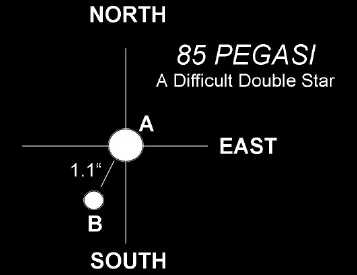
From the positional chart above, you can see that the 11.2 magnitude companion star of 85 Pegasi is just barely west of SOUTH; I have drawn the chart to correspond with the field of view of a Maksutov and Schmidt-Cassegrain, with North at top, and East to the right as it appears with the diagonal mirror in place. The current separation of only 0.8" arc is right at the limit of the LX 90, but I have seen the faint star clearly with the ETX 125 on several occasions this year. Note that in TWO years, the star will have increased its separation to near maximum (1.0") and will be due SOUTH of the primary. This is a short-period double orbiting in a period of only 27 years, and the true double is ONLY 40 light years distant from Earth! Although the main star - magnitude 5.8 - can be spotted easily in the ETX 60, 70 and 90, the faint and close companion star will not be seen.
Object 6 - A Nova In Progress? AG Pegasi - Robert Burnham's "Permanent Nova"
A very interesting object to talk about, yet one with little action right now....but you never know. In the mid-1800's this star suddenly brightened from it normal magnitude of around 9.2 to brighter than 6 in only 20 years; during and after this brightening the star began to show very peculiar spectral changes as well, indicating that the star was turning more red, and evolving quickly to a very "late" type star of the Red Giant category. At present the star is at magnitude 8.7 and exhibits very minor light variations as it SEEMS to be once again slowly fading back down to its original magnitude. This star can be easily monitored in all scopes - provided that you can zero-in on the RIGHT star! It does have a reddish hue about it and that might help you to locate and center it.....once you "think" you have the correct star, increase the magnification to about 20x per inch for observation in all scopes.
The American Association of Variable Star Observers has only a limited resource chart available for this curious star which I have revised to include magnitudes of comparison stars and shown below. Using this chart, which has NORTH at top and EAST to the right as you would see in your ETX or LX scope, you should be able to find this medium-brightness star in the not-so-crowded star field. Note that it is ONLY 3.3 degrees northeast of bright Epsilon Pegasi, so find that star first and zero in on AG Peg from there!
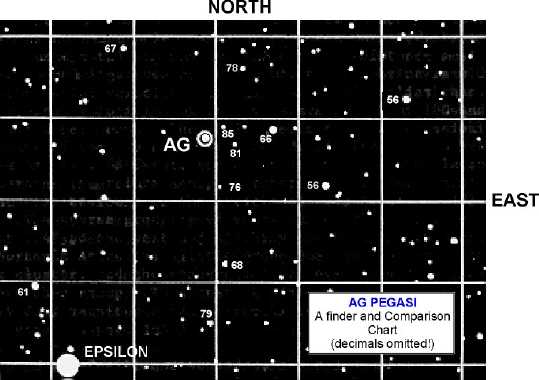
Object 7 - A Beautiful and Relative Easy to See Large Spiral Galaxy - ngc7331
Almost exactly 4 degrees due north of bright Eta Pegasi ("Matar", magnitude 2.9) is a very fine nearly-edge-on spiral galaxy. This has a total magnitude of 9.7 and stretch is a very thin oval shape for 10' x 2' across" This is a very large object, but relative faint since its brightness is spread out over a linear dimension that is nearly one-half the span of the moon's disk! Very similar to the famous Andromeda Galaxy, ngc7331 is much farther than M-31, at a distance of 50 million light years, compared to 2.3 million for Andromeda. As can be seen in the beautiful photograph of ngc7331 below taken through the giant 200" Palomar reflector, the galaxy is oriented almost perfectly N-S in our scopes; in the ETX 60 and 70, you can see a very faint but distinct "smear" of light from this if you look about one field north of Eta Peg. Once found increase magnification in those scopes to about 70x for direct observation; it is clearly seen in the ETX 90 and in my LX 90 the object is just fantastic in very dark skies. Averted vision and a power of about 120x in the ETX 125 and LX 90 are recommended for best views of this beautiful galaxy!
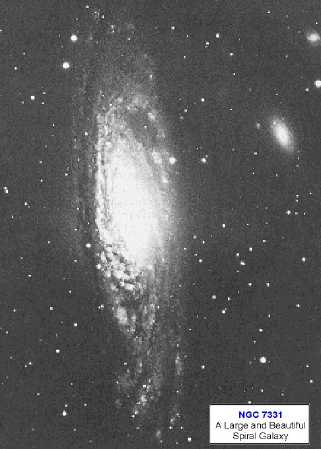
Object 8 - Another Nice, But Faint, Galaxy - ngc7814 - The "Little Sombreo"
Here is one galaxy that I personally wish was closer to us than it is....ngc 7814 is a miniature "Sombrero Galaxy", oriented edgewise and appearing photographically very much like that object. In the LX 90 the dark dust lane bisecting the oval shape can be clearly seen on a very dark night. However, this galaxy is very faint (less than magnitude 11) and appears ONLY as a distinct ellipsoidal glow in both the ETX 125 and LX 90; I would not expect to see much if anything in smaller telescopes of this object. It is a relatively large (5.1 x 0.9' arc oval) galaxy and what light we see is very highly concentrated near the center "hub" as you can clearly see in the Mt. Wilson 100" telescope photograph shown below.
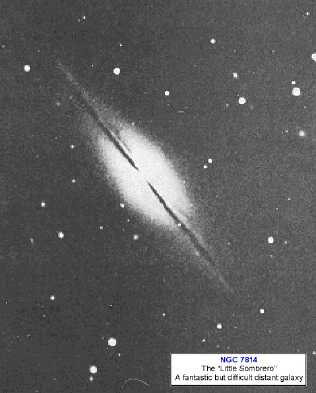
Object 9 - A Galaxy With an Interesting Shape - ngc7479
Here is a good (but very faint!) galaxy to test your eyesight on. Seen only in the ETX 125 and LX 90, this spiral galaxy is fairly large at 3.4' x 2.6' across but - as the photograph below taken through the 61-inch telescope of the U.S. Naval Observatory shows - is quite thin and "spindly". Note in the photograph the very distinct S-shape to the galaxy and particularly the "arm" which extends UP (north) in this photograph.
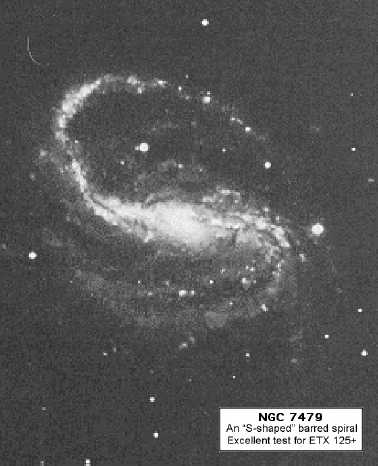
This arm, as well as the thin inner portions of the galaxy can be clearly glimpsed in the ETX 125 even though the total magnitude of the galaxy is a pale 11.7 visually. In addition, I can see a short extension to the right (east) of center in the galaxy as well, but only in the LX 90. This galaxy CAN be seen in the ETX 90 if the skies are very deep and moonless. Expect little or no detail in the ETX 90 other than a "pencil-shaped" elongation that appears to run NE to SW.
Object 10 - A Large and Bright Globular Cluster - Messier 15
It's never fair to compare globular clusters to one-another, particularly all the others to the likes of Messier 13 in Hercules or Omega Centauri in our southern skies. Nonetheless, Messier 15 can hold its own in very beautiful and rich clusters, probably among the BEST five in the sky. Having revealed over 140 variable stars in this very distant (39,000 light years!) globular, M-15 is a very bright ( 5.9 ) and large (7.4' arc) object for our telescopes. However, it is pale by comparison to the larger Messier 13 which stretches nearly TWICE the span of M-15.
In the ETX 60 and 70, the object is unmistakable, appearing as a "coarse" and large oval mass, very distinct against the background stars (actually MOST of the stars that you will see in your field of view are CLOSER than the globular cluster!). Moving up to the ETX 90, the outer "rim" stars can be distinctly seen and perhaps in this scope can best be seen a peculiar nature of this cluster...NOT seen in the larger and brighter counterparts. Messier 15 is more elliptical than spherical, and this oval shape is unmistakable in the ETX 90 at medium (about 75x) powers. Because the stars become more and more resolved with increased aperture, the ETX 125 and LX 90 do not exhibit this elliptical shape as readily. Expect many stars to be seen in the LX 90, with a very high concentration (more than with Messier 13) of stars near the center 1/3 of the cluster.
--------------------------------
WANDERING ABOUT....YOUR NEW "USER OBJECT" IN PEGASUS
Here is a very interesting QUADRUPLE star for your Autostar library and one that you would likely overlook and never pursue if you could not GO TO it directly. The star is known as "STRUVE 2879" and is a wonderfully bright and easy star for our telescopes (consult with my diagram below for the actual positions of these stars in your telescope). Note that ALL of the four stars will be easy (under dark sky conditions) in the ETX 125 and LX 90.....THREE of them with the ETX 90 and at least TWO with the ETX 60 and 70. We will call the primary (or brightest) star "A" with its magnitude of a relatively bright 6.4 (can be seen in the 8 x 21 finder and above).
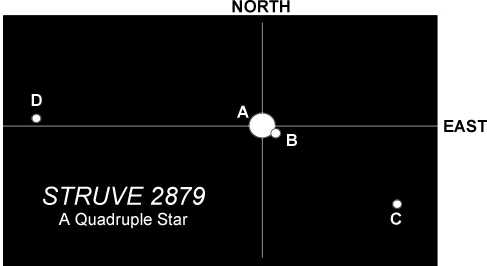
The first companion star "B" is magnitude 8.0 and is the most difficult for all but the ETX 125 and LX 90 to locate, right at the limit of resolution for the ETX 90 - 1.4" arc. Look for this star using fairly high magnification (about 40x per inch aperture) due SE of "A".
The second star, "C", will be found from "A" at exactly the same angle (SE) except it will be much farther and dimmer than star "B".....about 66" arc, or slightly larger than Jupiter would appear in the same eyepiece, but definitely right in line with stars A & B! At magnitude 9.5, this star will definitely be seen in ALL telescopes, even at medium magnification.
Now look for star "D", magnitude a faint 11.0, about TWICE the distance that "C" is from "A" (124" arc D to A) nearly DUE WEST of "A". This star will NOT be visible in the ETX 60 or 70 and will present somewhat of a test for the ETX 90 as well, although it should be an easy object due west of the primary star in the ETX 125 and larger telescopes.
On AutoStar, go to: "Select/Object [enter]...." scroll down to "User Object" [ enter]. Now enter the coordinates given above for "Struve2879", using the number keys on AutoStar. After entering the coordinates and pressing "Enter" yet again, scroll down one and you can list the magnitude of the object as "6"[Enter].
Now, in addition to black holes, quasars, novae, places of historical interest and other curious and weird among the celestial showcase....you have a quadruple star in your USER OBJECT DATABASE! All of these are wonderful for conversation-starters and crowd-stoppers at the big astronomical events!
Next Constellation GO TO" TOUR Installment: LEAPIN' LIZARDS! It's LACERTA. We will explore the scaley, slimy depths of this this celstial reptile and reveal that behind the cold-blooded facade of this small northern constellation are actually quite an array of beautiful attributes! Tune in for a GO TO of some nice deep sky objects, interesting double stars and some beautiful wide field deep sky Milky Way views, even for the naked eye. See....lizards aren't all that bad, are they?
Good Observing and explorations of this wonderful world of deep space!
P. Clay Sherrod
Arkansas Sky Observatory
Conway / Petit Jean Mountain
Arkansas
Return to the top of this page.
Go back to the Observational Guides & References page.
Go back to my ETX Home Page.